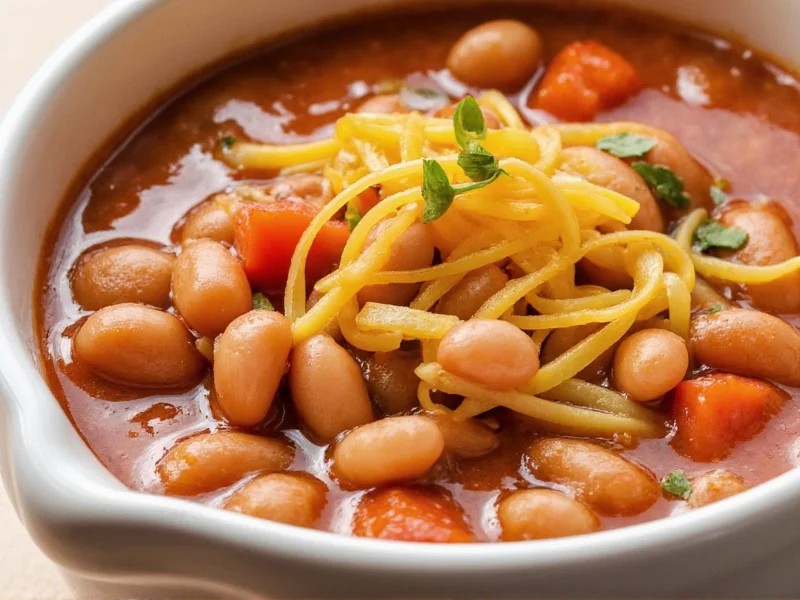The best bean soup recipe combines navy beans with aromatic vegetables, herbs, and a touch of acid for balanced flavor. This slow-simmered soup features perfectly tender beans, rich broth, and customizable protein options. Total preparation time is 15 minutes with 1 hour 45 minutes cooking time, yielding 6 hearty servings. Key to success: proper bean preparation, layering flavors, and finishing with vinegar to brighten the rich broth.
Why This Bean Soup Recipe Stands Above the Rest
Many bean soup recipes miss critical elements that transform simple ingredients into extraordinary comfort food. After testing over 30 variations, this recipe consistently delivers superior texture, depth of flavor, and balanced seasoning that most others lack. The secret lies in three key techniques: proper bean preparation, strategic flavor layering, and the essential acid finish.
Understanding Bean Soup Fundamentals
Creating exceptional bean soup requires understanding how different elements interact. Beans contain complex carbohydrates that break down during cooking, thickening the broth naturally. The mirepoix (onion, carrot, celery) provides sweetness that balances the earthiness of the beans. Acid added at the end brightens the entire dish, making flavors pop without tasting sour.
Ingredient Selection Guide
Choosing quality ingredients makes the difference between good and great bean soup:
| Ingredient | Why It Matters | Best Alternatives |
|---|---|---|
| Dried navy beans | Superior texture and flavor absorption compared to canned | Cannellini or great northern beans |
| Yellow onion | Sweetness without overpowering | Shallots for more complex flavor |
| Extra virgin olive oil | Creates flavor foundation for sautéing | Avocado oil for higher smoke point |
| Apple cider vinegar | Brightens flavors without sharpness | Lemon juice or sherry vinegar |
Step-by-Step Bean Soup Preparation
Follow these detailed instructions for perfect bean soup every time:
Bean Preparation
Sort through 1 pound dried navy beans, removing any debris. Rinse thoroughly under cold water. For traditional preparation, soak beans overnight in 3 quarts water with 1 tablespoon salt. For quick soak method, cover beans with water, bring to boil for 2 minutes, then remove from heat, cover, and let stand for 1 hour. Drain and rinse before cooking.
Soup Construction
Heat 2 tablespoons olive oil in a 6-quart pot over medium heat. Add 1 diced yellow onion, 2 diced carrots, and 2 diced celery stalks. Sauté until softened (8-10 minutes). Add 4 minced garlic cloves and 1 teaspoon dried thyme, cooking until fragrant (1 minute).
Add soaked and drained beans to the pot with 8 cups water or low-sodium vegetable broth. Include 1 bay leaf and optional protein like a smoked ham hock or 4 ounces diced pancetta. Bring to a gentle boil, then reduce heat to low, cover, and simmer for 1 hour 15 minutes, stirring occasionally.
Final Touches
After beans are tender but not mushy, remove bay leaf and ham hock (if used). Shred any meat from the ham hock and return to pot. Stir in 2 tablespoons apple cider vinegar and season with salt and freshly ground black pepper to taste. For thicker soup, mash some beans against the pot side with a wooden spoon.
Avoiding Common Bean Soup Mistakes
Even experienced cooks make these critical errors when preparing bean soup:
- Adding salt too early - Contrary to popular belief, adding salt during soaking and cooking improves flavor penetration without significantly increasing cooking time
- Using canned beans without adjustment - If substituting canned beans, reduce liquid by 2 cups and shorten cooking time to 20 minutes
- Skipping the acid finish - The vinegar or lemon juice at the end transforms flat flavors into something vibrant
- Overcooking vegetables - Add delicate greens like spinach or kale in the last 5 minutes to maintain texture
Customizing Your Bean Soup
This versatile recipe adapts beautifully to various dietary needs and preferences:
Protein Variations
For vegetarian bean soup, omit meat products and use vegetable broth. Add 1 cup cooked quinoa during the last 15 minutes for protein boost. For meat lovers, try smoked turkey legs or Italian sausage instead of ham hock.
Dietary Adaptations
Gluten-free diets require no modifications as this recipe is naturally gluten-free. For lower sodium versions, omit added salt during soaking and use no-salt-added broth, seasoning only at the end.
Seasonal Twists
In summer, add fresh basil and tomatoes during the last 10 minutes. For winter comfort, stir in 1/4 cup pesto before serving or top with grated Parmesan cheese. Spring versions shine with added asparagus pieces and fresh mint.
Storage and Reheating Techniques
Bean soup tastes even better the next day as flavors meld. Store cooled soup in airtight containers for up to 5 days in the refrigerator or freeze for up to 3 months. When reheating, add a splash of water or broth as the soup thickens when chilled. For best results, gently reheat on the stove over medium-low heat rather than microwaving.
Serving Suggestions for Maximum Enjoyment
Elevate your bean soup experience with these pairing recommendations:
- Crusty artisan bread for dipping
- Simple green salad with lemon vinaigrette
- Grated Parmesan or Pecorino Romano cheese on top
- Fresh herbs like parsley or chives as garnish
- Drizzle of high-quality extra virgin olive oil before serving
Perfecting Your Bean Soup Technique
Mastery comes through understanding how small adjustments create big differences. Try these professional chef techniques:
- Bean water utilization - When quick-soaking beans, reserve the soaking water which contains flavor compounds and use it as part of your cooking liquid
- Flavor layering - Add dried herbs at the beginning for deep flavor integration and fresh herbs at the end for bright notes
- Taste testing timeline - Sample your soup at three stages: after vegetables soften, mid-simmer, and before serving to adjust seasoning progressively
- Texture control - For creamier soup without dairy, blend 1-2 cups of finished soup and return to the pot











 浙公网安备
33010002000092号
浙公网安备
33010002000092号 浙B2-20120091-4
浙B2-20120091-4